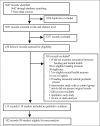Associations between maternal psychological distress and mother-infant bonding: a systematic review and meta-analysis
- PMID: 37316760
- PMCID: PMC10333415
- DOI: 10.1007/s00737-023-01332-1
Associations between maternal psychological distress and mother-infant bonding: a systematic review and meta-analysis
Abstract
Purpose: Maternal psychological distress and mother-infant bonding problems each predict poorer offspring outcomes. They are also related to each other, yet the extensive literature reporting their association has not been meta-analysed.
Methods: We searched MEDLINE, PsycINFO, CINAHL, Embase, ProQuest DTG, and OATD for English-language peer-reviewed and grey literature reporting an association between mother-infant bonding, and multiple indicators of maternal psychological distress.
Results: We included 133 studies representing 118 samples; 99 samples (110,968 mothers) were eligible for meta-analysis. Results showed concurrent associations across a range of timepoints during the first year postpartum, between bonding problems and depression (r = .27 [95% CI 0.20, 0.35] to r = .47 [95% CI 0.41, 0.53]), anxiety (r = .27 [95% CI 0.24, 0.31] to r = .39 [95% CI 0.15, 0.59]), and stress (r = .46 [95% CI 0.40, 0.52]). Associations between antenatal distress and subsequent postpartum bonding problems were mostly weaker and with wider confidence intervals: depression (r = .20 [95% CI 0.14, 0.50] to r = .25 [95% CI 0.64, 0.85]), anxiety (r = .16 [95% CI 0.10, 0.22]), and stress (r = .15 [95% CI - 0.67, 0.80]). Pre-conception depression and anxiety were associated with postpartum bonding problems (r = - 0.17 [95% CI - 0.22, - 0.11]).
Conclusion: Maternal psychological distress is associated with postpartum mother-infant bonding problems. Co-occurrence of psychological distress and bonding problems is common, but should not be assumed. There may be benefit in augmenting existing perinatal screening programs with well-validated mother-infant bonding measures.
Keywords: Maternal-infant bonding; Mental health; Meta-analysis; Perinatal; Systematic review.
© 2023. The Author(s).
Conflict of interest statement
GO was supported by an Australian Government Research Training Scholarship. ES was supported by an Alfred Deakin Postdoctoral Research Fellowship from Deakin University, Australia. JM and DH received an Australian Research Council Grant (DP160103160) which provided funding to the Australian Temperament Project to collect data on maternal mental health and mother-infant bonding which has been published in one of the included studies in the meta-analysis. Payments were made to JM’s and DH's institution, Deakin University. JM and DH are investigators on the study but did not personally receive funds. DH received an NHMRC Project Grant (APP630517, 2010-14) which provided funding to the Triple B pregnancy cohort study to collect data on maternal mental health and mother-infant bonding which has been published in three of the included studies in the meta-analysis. DH is an investigator on the study but did not personally receive funds. All other authors declare that they have no competing interests.
Figures

References
-
- Austin M-P, Highet N, COPE Expert Working Group . Mental Health Care in the Perinatal Period. Australian Clinical Practice Guideline; 2017.
-
- Bass PF III, Bauer N (2018) Parental postpartum depression: More than “baby blues”. Contemp PEDS J 35(9)

